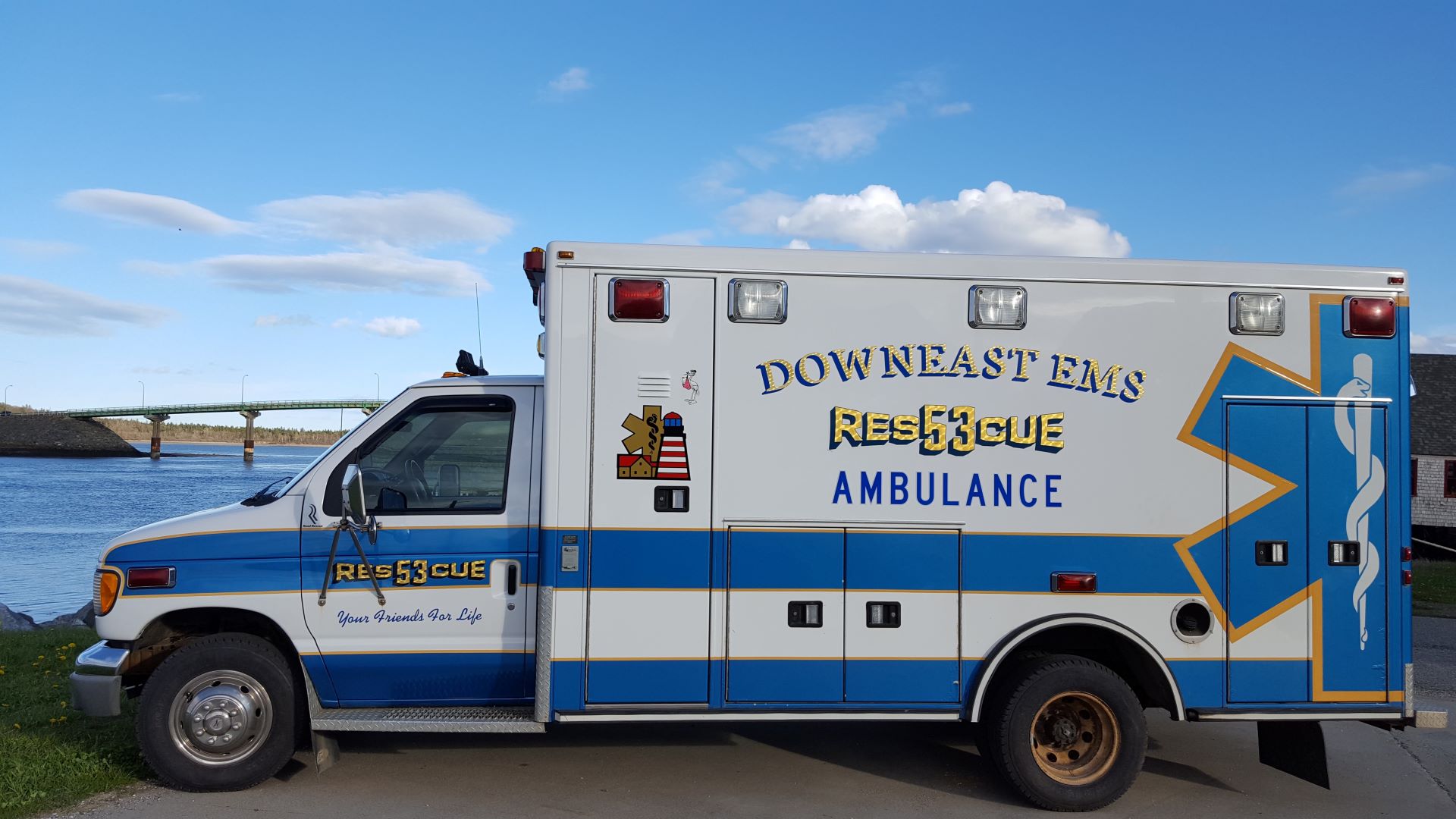The New Year rang in with sirens for two people last week on an icy, lonely stretch of road in western Washington County. The first person slipped and fell, soon becoming hypothermic. A good Samaritan tumbled alongside during a would-be rescue attempt, breaking a hip.
Petit Manan Ambulance Corps, which serves Milbridge and Steuben, arrived with a driver and an emergency medical technician (EMT). The Cherryfield Ambulance Service, which covers four more towns, came with only one paramedic — doubling as her own ambulance driver.
Two injured people, two ambulances but only one driver between them. Fortunately a fireman who was also on the scene agreed to drive, allowing each ambulance to have a certified medical responder on board en route to the hospital.
It was another close call in Washington County, where officials say the emergency management system is near crisis because of a staffing shortage that often leaves large swaths of the largely rural area with little or no ambulance coverage. They say many of Washington County’s 10 ambulance services are hanging on, struggling to recruit EMTs and scrape together the funding to pay them even meager wages.
“The EMS system is on the brink of failure,” said Rick Petrie, Special Projects Advisor for Atlantic Partnership EMS, a statewide nonprofit EMS support agency. “The only reason it hasn’t failed is because of the dedication of the people who are doing it. They always find a way to respond.”
Petrie and other EMS officials are searching for solutions, ranging from increased tax funding from towns to state money from the legislature. They are hosting a county EMS meeting from noon to 2 p.m. Thursday, with all Washington County town and EMS officials urged to attend, in person or via zoom.
But in the meantime, EMS officials across the county told The Maine Monitor they’re facing tight staffing and tight budgets — and the risk of a medical emergency.
RELATED: Washington County Hospital CEO says ambulance shortage ‘backs up the entire system’
Nancy Parritt, the Petit Manan service chief, urged the towns funding her service to begin paying a fee of $25 per capita, which would be one of the lowest rates charged by emergency medical services in the county. That would amount to about a six-fold increase for Steuben and a 13-fold leap for Milbridge.
Otherwise the service might have to shut down. “I went to the select boards two weeks ago and told them, we’re straight out and we’re getting done unless you can pay us enough to help keep us going,” said Parritt, who is in her 70’s and has been an EMT for 48 years.
And yet, Parritt’s warning was answered with resounding no votes from the Milbridge and Steuben boards. The towns are not legally obligated to say yes. The state doesn’t have laws requiring towns to provide EMS.
“We don’t want to see Petit Manan crash and burn,” Steuben Selectwoman Eve Parkin said, “but if we would have said yes, then things just keep going the way that they are.”
Petit Manan’s nonprofit ambulance service is funded by private insurance payments, along with Medicare and MaineCare (the state’s Medicaid) reimbursements, which only pick up about 75 percent of the ambulance’s cost. Petit Manan also gets stipends of $2,500 from Milbridge and $5,500 from Steuben. All told, it’s still not nearly enough to meet a roughly $250,000 yearly operating budget.
According to Petrie, some ambulance services lose as much as $2,000 a call. Petit Manan’s losses in 2020, the most recent tax filing available from the Internal Revenue Service, were more than $13,000, a 34 percent spike over the previous year, a steady trend.
Petit Manan’s problems are not unique. Nor are they the only EMS in the county on the brink of shuttering. Sipayik Ambulance Corps on Pleasant Point essentially has.
“Theoretically they’re not out of business,” said Eddie Moreside, director for Downeast EMS. “They couldn’t get anybody to staff their ambulance, so we’ve been covering their area too for about a year now.”
Downeast EMS runs nine ambulances out of bases in Baileyville, Lubec and Eastport, getting stipends of $27 per capita plus a fee from the towns where they are based. They cover roughly a third of Washington County, with seven full-time EMTs, two paramedics, and 18 part-time EMTs and drivers. Moreside said they answered about 1,900 calls last year; about 30 percent were inter-hospital transfers.
With a $1.7 million budget, they’re consistently in the black.
“Ten years ago we restructured and took a deep dive into how we needed to operate,” Moreside said. “Thank God it came together.”
Moreside credits sound management, cooperation from community partners and the willingness of his crews to work long hours when needed to fill any gaps. And there are gaps. Staffing is a statewide, as well as a countywide, challenge. Two-and-a-half-years ago, Downeast EMS had a roster of 45. Today, despite offering benefits, there are only 28 people on staff.
RELATED: ‘Ghost stations’ in rural Maine mask depth of firefighter shortage
On any given day, as many as two or three ambulance services countywide could be out of service, and often are, because crews are unavailable, leaving ambulances idle. That means another ambulance company has to pick up the slack, increasing the distance traveling to a call and thus the response time.

Renee Gray is service chief for Moosabec Ambulance Service, which serves Jonesport and Beals. Last year it answered 250 calls but struggled to staff the ambulance. Gray said the situation is a disaster waiting to happen.
“We’ve had overdoses where the individual is blue and not breathing,” Gray said. “With our fast response time, CPR, and Narcan, we can get them back. If we can’t respond, that person is not going to last 40 minutes to an hour.”
Moosabec is “out of service” at least every Saturday. That’s Gray’s one day off as an EMT and from her full-time job as the Lubec town administrator.
Gray, who is married and has a 16-year-old daughter, shares most of the ambulance shifts with an EMT who has another job as a pastor. A third EMT, who works full time as a dispatcher at the 9-1-1 Regional Communications Center (RCC) in Machias, covers a couple of shifts a week.
Due to staffing shortages, ambulance companies are declining some or, in some cases, all hospital transfers. A single transfer sometimes can take an ambulance “out of service” for an entire day when patients have to be taken to Bangor or beyond. The self-preservation decision is having a harmful impact at DECH in Machias and its sister hospital in Calais, where patients are often stranded in the emergency room.
According to Steve Lail, the DECH president and CEO, there are times when over half of DECH and Calais ER beds are filled with long-term patients waiting to be placed.
“We’ve had four to five to six patients that are waiting to be transferred to long-term care, to behavioral health, or to a higher level of care,” Lail said. “I think it does have a detrimental effect on patients’ health at times.”
Emergency calls throughout the county are coordinated through the Regional Communications Center, which handles about 20,000 9-1-1 emergency dispatches annually. About 3,900 of them are ambulance calls, according to Josh Rolfe, the RCC deputy director.
When an ambulance service can’t get a crew together — or is transferring a hospital patient from the DECH or Calais hospitals to another facility as far away as Bangor or even Portland — Rolfe said dispatchers have to scramble to find a backup to cover the call. That extra shuffling — and the extra distances those backups have to travel — add life-saving minutes.
“Ambulance responses are stretched very thin,” Rolfe said. “I don’t think the general public is really aware of how fragile ambulance coverage is to the western part of Washington County.”
The Workforce: Dedicated but stressed
EMS officials say there are many reasons for the declining number of EMTs. Abysmal pay tops the list, with wages maxing out around $20 per hour for paramedics; for basic level EMTs, the pay hovers just above minimum wage. Also, in most cases EMTs only get paid for time spent on a call. Or not at all.
Wayne and Roberta Seeley, who are in their late 70’s, have been volunteer EMTs for the Dennys River Ambulance Service for 50 and 47 years, respectively. They answered 167 calls last year and won’t be stopping anytime soon.
“I don’t think we would go out the door until we made sure there was enough people to cover it — or unless something happens to us,” Roberta Seeley said.
But the volunteer heroism that keeps Dennys River in service is an anomaly. Ambulance services are hard-pressed to recruit EMTs, even with pay. More is being asked of those who want to provide EMS to their communities.
The requirements are increasingly more stringent: 160 hours of training to become a basic EMT; up to 1,800 hours to become a paramedic; grueling hours, often in the middle of the night; and ongoing, rigorous testing.
Then there is the emotional toll.
Machias paramedic Sally Taylor is the director of Atlantic Partners EMS, Region #4. Taylor said what EMTs experience is worse than burnout. She calls it “rustout,” comparing the psychological damage to the erosion of a barrel beat down by rain until it rusts and breaks apart.
“You could be extricating four teenagers out of a motor vehicle that crashed into a tree going 90 miles an hour,” Taylor said. “That does things to the psyche.”
Solutions coming — Maybe
There is some hope. The county is in line for a fellowship through the state Volunteer Maine program that would provide a full-time EMS recruiter for the county for one year. Taylor and Gray, Moosabec’s chief, spearheaded the effort and are optimistic the fellowship will come through and could even be renewed beyond the first year.
Another option could be regionalization. NorthStar, the regional ambulance service for Greater Franklin County, operates as a program of Franklin Memorial Hospital.
Asked about that approach, Lail said he wouldn’t rule it out, adding that DECH leadership has already been exploring options with state officials.
“We would definitely think about a partnership or some arrangement,” Lail said. “We’re waiting for the state to get back in touch, to discuss from their side what those options would be and how those would fit into a hospital system.”
Lail expects a response from the state within the next couple of weeks and is hopeful solutions will be found before it’s too late to save Petit Manan and possibly others. He said DECH has also been talking with state representatives trying to find solutions.

Meanwhile, other emergency measures are underway. The state’s commission to study emergency medical services made recommendations to the Legislature in December that could provide EMS across the state with additional funding. The commission called for an additional $70 million in funding per year for the next five years to support transporting EMS services in the state. They also recommended an initial allocation of $25 million of that $70 million appropriation to specifically target transporting EMS services at immediate risk of failing.
Washington County EMS advocates say the money would help but is only a temporary, partial fix. AP EMS’ Petrie and Taylor say immediate action is needed.
Petrie said hard discussions are needed now and all options must be on the table, including possibly regionalization, and definitely some form of a taxpayer-funded model. Petrie said the antiquated self-funded model is unrealistic. Not unsurprisingly, many towns balk at any taxpayer solution, and some ambulance companies balk at regionalism, most citing the county’s 2,563 square mile coverage area.
“There’s just no way it would work for (those) in this end of the county,” Dennys River EMT Roberta Seeley said. “It doesn’t even seem sensible, we’re all spread out so much.”
Sign up here to receive our free, periodic newsletter, Downeast Monitor, that focuses on Washington County news, a new offering at The Maine Monitor as part of our newsroom’s stepped-up efforts to cover Washington County. Know of a Washington County story we should look into? Send us an email: gro.r1751323342otino1751323342menia1751323342meht@1751323342tcatn1751323342oc1751323342 or send the tip anonymously here.








